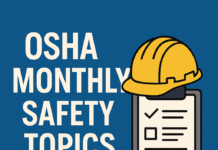
Top 10 OSHA Violations in 2024
The Occupational Safety and Health Administration (OSHA) plays a crucial role in ensuring workplace safety across various industries. With regulations in place to protect employees from hazards, it’s essential for employers to adhere to OSHA standards to maintain a safe working environment. As we delve into 2024, it’s imperative to highlight the most common OSHA violations observed in workplaces. Let’s explore the top 10 OSHA violations in 2024 and understand the importance of compliance.
1. Fall Protection Violations
Falls are among the leading causes of workplace fatalities and injuries. Failure to provide adequate fall protection, such as guardrails, safety nets, or personal fall arrest systems, often results in serious consequences.
2. Hazard Communication Violations
Proper communication of hazards in the workplace is essential for employee safety. Violations in hazard communication include inadequate labeling of chemicals, lack of safety data sheets, and failure to train employees on handling hazardous substances.
3. Scaffolding Violations
Improperly constructed or maintained scaffolding poses significant risks to workers. Violations in scaffolding safety standards involve issues like inadequate platforms, lack of guardrails, and failure to ensure stability.
4. Respiratory Protection Violations
In environments where respiratory hazards are present, employers must provide appropriate respiratory protection equipment. Violations in this category include failure to conduct fit testing, improper respirator selection, and inadequate training on respirator usage.
5. Ladder Violations
Ladders are commonly used in various workplaces, but they can be hazardous if not used correctly. Violations related to ladders include using damaged or defective ladders, improper placement, and overloading.
6. Machine Guarding Violations
Machinery with moving parts can cause severe injuries if not properly guarded. Violations in machine guarding involve missing or inadequate guards, as well as failure to implement lockout/tagout procedures during maintenance.
7. Lockout/Tagout Violations
Lockout/tagout procedures are crucial for preventing unexpected startup of machinery during maintenance or servicing. Violations occur when employers fail to develop or implement proper lockout/tagout procedures, leading to potential injuries or fatalities.
8. Powered Industrial Trucks Violations
Powered industrial trucks, such as forklifts, pose significant risks in the workplace if not operated safely. Violations include lack of operator training, inadequate maintenance of equipment, and failure to implement proper traffic management protocols.
9. Eye and Face Protection Violations
Protecting the eyes and face from workplace hazards is essential to prevent injuries. Violations in this category include failure to provide appropriate protective eyewear, inadequate training on eye safety, and lack of regular inspections of protective gear.
10. Electrical Wiring Violations
Electrical hazards pose serious risks to workers, including electrocution and fires. Violations in electrical wiring safety involve issues such as exposed wiring, overloading circuits, and failure to provide ground fault protection.
These violations are often related to workplace safety standards and regulations, and they can vary depending on industry and workplace conditions. For the most accurate and up-to-date information on OSHA violations in 2024, I recommend checking the official OSHA website or other reliable sources.Consequences of OSHA Violations
Violating OSHA standards can have severe consequences for employers, including hefty fines and penalties. Moreover, it can lead to injuries, fatalities, and damage to the organization’s reputation. It’s crucial for employers to prioritize safety and comply with OSHA regulations to protect their employees and business interests.
Tips for Preventing OSHA Violations
Preventing OSHA violations requires a proactive approach to workplace safety. Employers should invest in employee training and education, conduct regular inspections and audits, and foster a culture of safety where employees feel empowered to report hazards and participate in safety initiatives.
Conclusion
Maintaining compliance with OSHA regulations is vital for ensuring the health and safety of workers. By addressing common OSHA violations and implementing preventive measures, employers can create safer workplaces and mitigate risks associated with non-compliance.
OSHA Standards for Construction and General Industry
OSHA: Hazard Communication Standard 1926.59
FAQs (Frequently Asked Questions)
- What is OSHA?
- OSHA stands for the Occupational Safety and Health Administration, a federal agency responsible for setting and enforcing workplace safety standards in the United States.
- What are the consequences of OSHA violations?
- OSHA violations can result in fines, penalties, and potential legal action. Additionally, non-compliance can lead to injuries, fatalities, and damage to the organization’s reputation.
- How can employers prevent OSHA violations?
- Employers can prevent OSHA violations by prioritizing safety, providing adequate training, conducting regular inspections, and fostering a culture of safety in the workplace.
- What are some common workplace hazards addressed by OSHA regulations?
- OSHA regulations address a wide range of workplace hazards, including falls, chemical exposures, electrical hazards, and machinery-related injuries.
- Where can employers find resources for OSHA compliance?
- Employers can access resources for OSHA compliance through the official OSHA website, which provides guidance documents, training materials, and other useful resources.
























